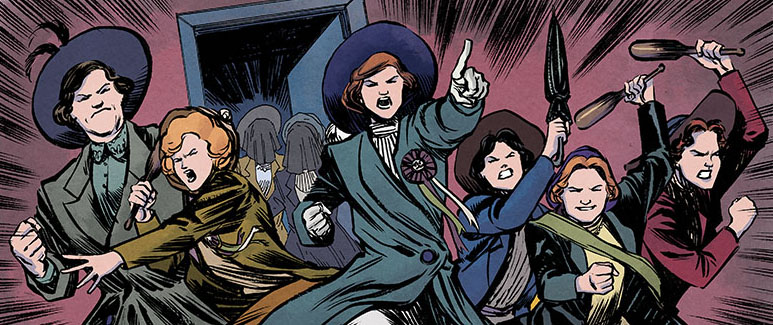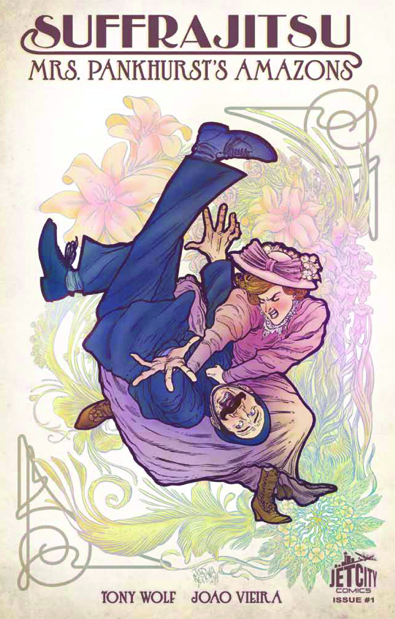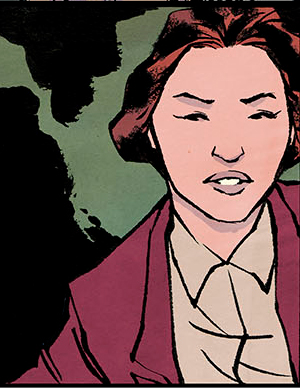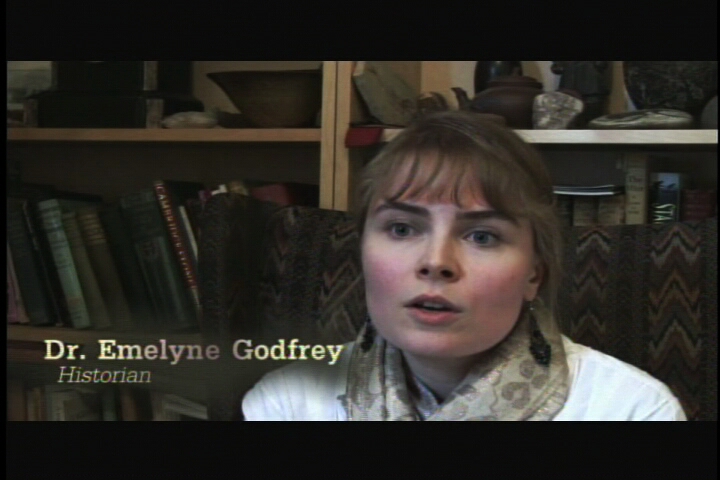
From Suffragettes
Kitty Marshall: Suffragette bodyguard
In the Suffrajitsu graphic novel, Kitty Marshall is portrayed as the youngest member of the Amazon bodyguard team. In real life, she was one of the very few members of Mrs. Pankhurst’s undercover security team whose activities were recorded for posterity …
From Jujitsu Suffragettes, by Emelyne Godfrey, BBC History Magazine Nov. 2012.

Katherine Willoughby Marshall, a member of Emmeline’s bodyguard team, later recalled:
“Our orders were that as the clock struck nine we were to jump out and attack the seven policemen and detectives, who had been placed in front of the house where Mrs Pankhurst was a prisoner. Behind our taxi was also another lot of bodyguards, and as the clock struck nine, out rushed the bodyguards who had remained at the house. The blue car was directly in front of the front door, and all of us fell on some policeman or detective. I chose a big man with a large mackintosh cape. I knocked his helmet over his eyes and brandished my Indian club about his head. Out came Mrs. Pankhurst and into the blue car, which was driven away by a smart woman driver, hell for leather…
The bodyguard (and) I got into the waiting taxi and away it went with orders to drive as quickly as possible to Piccadilly Circus. The taxi driver was very interested and wanted to know what it was all about, so I told him that we had helped Mrs. Pankhurst to escape. He said he had never seen anything like it and was very intrigued to have been in the rescue.”
“Sandwina”, the Woman of Steel

Katharina Brumbach (1884-1952), better known by her stage name, “Sandwina”, was born into a family of Austrian circus athletes and strength performers.
As a teenager she received extensive physical training that augmented her natural gifts towards great strength. By the time she made her official debut in her family’s circus act – offering 100 marks to any man in the audience who could defeat her in a wrestling match – she already stood close to six feet tall and weighed in the region of two hundred pounds.
Her stage name was purportedly adopted after she defeated the famous strongman Eugen Sandow in a weightlifting contest during the very early 1900s (“Sandwina” being a feminine variant of “Sandow”). She and her husband, acrobat Max Heymann, developed a double act in which Sandwina played the role of a soldier going through a rifle drill, manipulating Heymann as if he were a rifle.
By 1911 the couple were touring vaudeville and circus circuits throughout the United States and Europe, with Sandwina performing numerous impressive feats of strength including bending iron bars, breaking chains and supporting enormous weights on her shoulders. She became particularly famous in America, where she was seen as an exemplar of several popular cultural trends including eugenics, physical culture and women’s suffrage. Circa 1912 she became the vice-president of a suffrage society within the Barnum and Bailey Circus, although she was quoted as saying that she feared suffrage might “masculinise” women.
Retiring from the circus life, Sandwina and her family opened a popular tavern and restaurant in Ridgeway, New Jersey, where she continued to perform feats of strength for their patrons every Saturday night. She also took a hand in training her son Teddy, who became a prominent professional boxer, during the 1920s and 30s.
A New York Mirror newspaper article of December 15, 1947 recorded an incident in which a “bruiser” had entered Sandwina’s bar, berated everyone in sight and then started aggressively for Max. Under such circumstances, Sandwina – known to all in the neighbourhood as “Mama” – was known to say to her husband, “Papa, open the door …”. She knocked the bruiser out cold with one punch and ejected him from the premises. Apparently, this sort of thing happened often enough that the local cops had developed a customary word of caution for Sandwina the strongwoman:
“Mama, don’t hit him too hard!”
Sandwina, the Woman of Steel appears as a member of the Amazon bodyguard team in the Suffrajitsu graphic novel series.

Neal Stephenson foreshadows “Suffrajitsu”
An excerpt from an interview by Douglas Wolk for the io9 website on May 30, 2012:
I ask Stephenson about the cane-fighting subgroup that drew Greg and Erik Bear into the project, and he’s off into explanatory mode again. (I’m not complaining. I could listen to Neal Stephenson explain stuff all day.) “It’s an interesting thing,” Stephenson says, “because from a distance 19th-century martial arts looks kind of dorky — it looks like Monty Python. It ties into everything we believe about the Victorians: that they were out of touch with their bodies, that they didn’t really understand medicine very well, and that they were uncomfortable with physical activities. But once you get into it, you find that these people really knew what they were doing in terms of physical culture, in terms of self-defense. Victorians were really serious about staying fit.
Part of what makes this an interesting story is how, in the 19th century, jiujitsu was adopted by women. This guy Barton-Wright brought jiujitsu to London. He came back from Japan and created a club called the Bartitsu Club. He taught the mixed martial art of jiujitsu, bare-knuckle fighting, savate, stick fighting and a few other things. He brought in a couple of teachers from Japan, and would take them around the music halls—have them challenge huge, burly guys and throw them around. This had an unintentional side effect that suffragettes would see these performances, and decide they wanted to learn self-defense: ‘I want to defeat a man!’ Jiujitsu as a ‘husband-tamer’!
We want to do a side-story quest thing about the jiujitsu suffragettes. The image that we’re all dying to get into a full-page spread in a comic book is this lineup of Edwardian women with the flowered hats and the long skirts and the bustles, and they’re all walking eight abreast down a London street, swaggering toward the camera and approaching a bunch of bobbies… if we could get that image in some medium, that would be a good thing.”
“Edith Garrud: a public vote for the suffragette who taught martial arts” (2012)
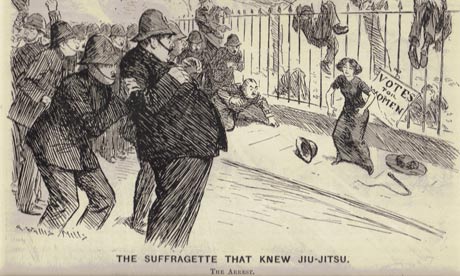
Click here to read journalist Rachel Williams’ article for The Guardian on Suffragette jiujitsu trainer Edith Garrud, including quotes from Tony Wolf.
The Amazons in pop-culture and in the media
The stories of the Suffragette Amazons were all but forgotten throughout most of the 20th century, but the Women’s Liberation movement of the 1960s and ’70s sparked a revival of interest in their “secret history”. Notable amongst these were Antonia Raeburn’s The Militant Suffragettes (1973), the BBC TV mini-series Shoulder to Shoulder (1974) and Midge Mackenzie’s companion volume Shoulder to Shoulder: The Stirring History of the Militant Suffragettes (1975).
The advent of the Internet has seen an increasing number of Suffragette Amazon-related media projects, from books and websites to documentaries and graphic novels.
The following is a summary of media that deal specifically with the Amazons, or in which their principals play key roles:
1982
Writer/director Noel Burch directs The Year of the Bodyguard, a docudrama for Britain’s Channel 4 that deals with the social history and lore of Mrs. Pankhurst’s Amazons. Unfortunately, it has never been released on DVD and modern screenings are extremely rare. We are, however, pleased to be able to present this interview with Mr. Burch in which he reminisces about the production, together with this detailed, illustrated summary of the docudrama itself.
In this scene from The Year of the Bodyguard, a group of Suffragettes escaping from the police after a window-smashing protest take refuge inside Edith Garrud’s jujitsu school. The scene is closely based on an anecdotal account of real-life events, as reported decades after the fact by Edith Garrud herself:
1998
Gretchen Wilson’s With All Her Might (1998) is a biography of her great-aunt, Gertrude Harding, who was one of the principal organisers of the Suffragette Bodyguard society.
2000

The Perfect Daughter, part of Gillian Linscott’s series of novels about Suffragette detective Nell Bray, features a martial arts-oriented subplot and Edith Garrud appears as a supporting character.
2005-08
Both volumes of the Bartitsu Compendium (2005/08), edited by Tony Wolf, feature collections of archival newspaper articles relating to Edith Garrud and the Bodyguard team’s martial arts training.
The Lady Cavaliers theatre company produces a short play, Mrs. Garrud’s Dojo, that offers a lighthearted look at early 20th century gender politics via “Suffrajitsu”.
2009

Tony and Kathrynne Wolf publish Edith Garrud – the Suffragette who knew Jujutsu to introduce the story of the Amazons to younger readers.
2011
The documentary Bartitsu: The Lost Martial Art of Sherlock Holmes, co-produced and co-directed by Tony Wolf and featuring an interview with Emelyne Godfrey showcases the Jujitsuffragettes and features a re-enactment of their combat training.

The play The Hooligan and the Lady, a dramatised biography of feminist jiujitsu pioneer Florence “Flossie” Le Mar, was a hit at the 2011 New Zealand Fringe Festival.
2012
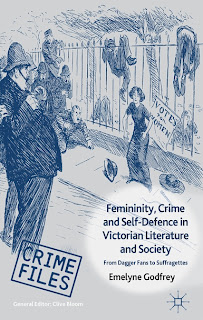
Emelyne Godfrey’s book Femininity, Crime and Self-Defence in Victorian Literature and Society: From Dagger-Fans to Suffragettes devotes a full chapter to the Bodyguard, Edith Garrud and Edwardian jiujitsu.

Anne Bertram’s play The Good Fight, performed by Theatre Unbound, explores the social and political pressures that led the WSPU to create the Bodyguard team.
Click here to listen to reporter Julian Bedford’s interview with Tony Wolf for the BBC World Service radio programme, concerning the Suffragette Bodyguards.
2013
The BBC documentary Everybody Was Kung-fu Fighting: A History of the Martial Arts in Great Britain (2013) showcases the Suffragette Amazons, featuring an excerpt from The Year of the Bodyguard and interviews with Emelyne Godfrey and Tony Wolf.
2014
Icon Films produces this mini-documentary on the life and times of jujitsuffragette trainer Edith Garrud, hosted by Honor Blackman and featuring an interview with Emelyne Godfrey.
2015
The graphic novel Suffrajitsu, written by Tony Wolf with art by João Vieira, is published via Amazon’s Jet City Comics imprint.

The mystery novel Move your Blooming Corpse, featuring Eliza Doolittle and Professor Henry Higgins as detectives in Edwardian London, also includes Edith Garrud and the suffragette Bodyguard team.
Edith Garrud demonstrates jiujitsu
“Suffragettes and Policemen: Amazons in the Making” (1910)
From the London Daily Mail, 25 August 1910:
A practical test of Suffragette jiujitsu took place the other evening between Mrs. Garrud, an expert in the Japanese art, and a policeman. Mrs. Garrud is one of the organisers of the women athletes’ branch of the Women’s Freedom League, and her object is to make jiu-jitsu an additional weapon of woman’s fight for the vote
The first policeman opponent was not an interrupter at a meeting, nor had he offered a Suffragette any insult, other than a doubt that Mrs. Garrud could toss him over her head. In explaining how it would be possible for the Suffragettes in future to police their own meetings and forcibly eject any of their one-time lords, Mrs. Garrud had casually remarked that for her part the overthrow of an average policeman would be a simple matter. In no way did the constable resent her expression of opinion, but his doubts were evident. A smile crept over his face as he stood regarding her. “Why,” he said, “you’re only a little dot of a woman.”
“Well., I’m not exactly a giant,” admitted the Suffragette. “If you’re sure you aren’t frightened of getting hurt, I think I’ll throw you.”
Again the big policemau smiled. It was all so very, very foolish. His great red hands played idly about his 43in chest, and then in a moment of vanity he clenched his right fist, so that the muscles of his forearm stood out in heavy lumps.
Mrs. Garrud is 4ft 10 inches in height, and she, too, smiled. “I’m glad you’re not more than thirteen stone,” she murmured.
Then the struggle commenced. As a huge mastiff would bend down upon au insolent kitten, the man swooped on the womau. First he tried for a catch-as-catch-can bodyhold, but the Suffragette eluded his grasp. Their hands met, and the giant tried to pull her to him, but that was the very last thing she intended to allow. Pulling away from him, she ran lightly backwards, with the policemau pressing heavily after her. Desperately he exerted all his strength, striving to push the woman off her balance aud on to the mat. Then, suddenly, the thing happened. In a flash the woman fell flat on her back, with the massive policeman towering above her. Up shot one of her feet to meet his diaphragm. Her little arms strained, and as he pulled against himself the man lost his balance, swirled over her head, turned a somersault in mid-air, and fell heavily on the back of his head. In less than ten seconds the Suffragette had thrown the policeman.
Five minutes later, when he once more condescended to stand upright, the puzzled policeman again carefully regarded Mrs. Garrud. Contemplatively he scratched his head. “If that had happened on the pavement instead of these mats the police force would be one man short at this moment,” he said. “That fall would have cracked my skull.”
Another policeman awaited his turn. Lighter in build than the other, but more alert and more athletic in every way, the second man had the further advantage of a sound knowledge of the secrets of jiu-jitsu. “Now I shall have to do something really decent,” said the Suffragette. ”That last bout was just child’s play. I’ll enjoy this much better.”
For a full minute they played for an opening. At first the man tried for a catch-as-catch-can hold, but the woman was too wary. Just as the policeman’s arms seemed to have locked about her she would slip away, and, clutching his wrists, attempt to pull him after her as she ran backwards to gain the impetus for the stomach fall which proved the first man’s downfall.
At last the man’s superior strength and great advantage in weight commenced to tell. Desperately she tried for a side-hold, and then the end came. Just failing to effect the grip, the woman was at the man’s mercy. High in the air he swung her and then down upon the mat she went. But even as she fell she made for a wristhold, missing it by an inch. Two taps on the floor as a signal that she was defeated and the woman rose smilingly for another bout.
The first position taught by Mrs. Garrud to her Suffragette pupils is the “trip.” After the theory had been carefully explained, the two women gripped each other firmly by the upper arms. They swayed a little, and then Mrs. Garrud pressed her opponent backwards a few steps, but out went the pupil’s foot against her shin, and down went the teacher. Lying as she fell, Mrs. Garrud explained the next positions — how to safeguard the face from being struck when bending over a fallen combatant to pin her to the ground, then how to pin both hands to the ground. This was repeated several times and another new “lock” added, which effectually quieted the instructress.
“I do not often teach more than two new features each day,” said Mrs. Garrud. “They are so apt to confuse them unless they practise very diligently. To master the art thoroughly requires about thirty-six lessons, but, of course, people can become efficient in less than a dozen.” As these combatants retired a girl came forward — it would be neither fair nor sportsmanlike to divulge her identity —who is nearing the completion of her course. Judging from the light-hearted and easy way in which she threw a man over her head half a dozen times, the London police force may well shake in their shoes at the prospect of what the future may hold.
Judith Lee – her new and wonderful detective feats – The Wrestler and the Diamond Ring
I had lately returned to my London flat following a strenuous and morally stimulating adventure in Tuscany. Sifting through the inevitable accumulation of mail, I discovered a telegram dated just the previous day. It read:
DARLING JUDITH STOP FAR TOO LONG STOP URGENT THAT WE MEET AT EARLIEST CONVENIENCE STOP PERSI
followed by a telephone number.
“Persi” could only be my old school chum, Persephone Wright. The particulars were quickly arranged and so I set out for the Café Royal in Regent Street that very afternoon, most curious as to what might have become of Persi in the decade since we had last met.
She had never been precisely demure, but Persephone’s appearance and manner as she swept into the gilt-and-turquoise café was positively Bohemian, all gypsy shawls, art nouveau jewellery, dark honey hair and feline grace.
“Judith, dear”, she began as soon as we broke our embrace, “it’s smashing to see you! Now, I do hope you’ll be able to help – my friend Armand has just been arrested and things are in an awful state!”
This occasioned some raised eyebrows amongst the other café patrons and I ushered her into a booth post-haste.
“Well, I shall do what I can to help,” I began once we were settled, “but please understand that I am not so much a detective as simply an inquisitive woman with a few unusual talents.”
Chief amongst those talents, as my regular readers will be aware, is my ability to read lips, a skill I have honed since young childhood and which I currently employ in my occupation as a teacher of the deaf. It has occasionally happened that I am able to “overhear” by sight certain confidences of an illicit nature, which I have felt morally compelled to investigate; by these means have a number of frauds, thieves and even murderers been brought to justice.
Over our afternoon repast of milky mint tea and crumpets, Persephone informed me that her uncle Edward was the proprietor of the famous Bartitsu Club in Shaftesbury Avenue, where the cream of London society took their exercise and learned the noble arts of self defence. The unfortunate “Armand” was Armand Cherpillod, the Club’s professor of physical culture and wrestling. Persephone described him as a kind and stalwart but unworldly man, of humble rural stock, who had emigrated from Switzerland some years earlier, at her uncle’s invitation. Since then, she said, Armand had often, and rather successfully, represented the Bartitsu Club in wrestling challenges upon the Tivoli and Alhambra stages.
“And what has brought this great wrestler so low?” I inquired.
Persi lit an exotic cigarette, perhaps to soothe her nerves.
“He has been accused of theft,” she said somberly. “The police found stolen property in his flat – a precious diamond ring that apparently belongs to Lady Lucy Duff-Gordon, the wife of Sir Cosmo Duff-Gordon, who was himself a student of Armand’s.”
“Lady Duff-Gordon – better known as Lucile? The fashion designer?” I asked.
“The very same.”
“But you believe that Armand is innocent?”
“Absolutely so. Armand says that he was, in fact, given this ring as a gift by another of his wrestling students, a woman named Marjorie. I strongly suspect that she is the true thief, or at least the villain’s accomplice.” Persephone’s deep blue eyes narrowed as she drew pensively on her cigarette.
“We’ve seen nothing of Marjorie since Armand was arrested, and she’d never missed a class before. Of course, Uncle Edward is very concerned, not just for Armand’s well-being but also for the honour of the Bartitsu Club. A scandal might ruin him.”
“Well then,” I said, “we must find this woman as soon as we can. I assume that you have explained all of this to the police?”
At this, Persi frowned again.
“Of course, but I’m afraid there’s little that I, or any associate of the Bartitsu Club, can say to the police that would influence them for the better,” she said. “They are thoroughly suspicious of the lot of us, at the present time.”
“But why?”
Persi exhaled a thin stream of smoke and then, knowing my talent at lip reading, spoke silently, her lips and tongue forming the words:
“Judith, I understand that you support the fight for women’s suffrage?”
I nodded in assent.
“You should know that the Club is the headquarters of Mrs. Pankhurst’s Amazon guards. The police are aware of that, though they’ve never been able to prove it; thus our dilemma.”
I understood at once. The Amazons were the subject of much newspaper speculation and street gossip; aside from serving as Mrs. Pankhurst’s personal bodyguards in sometimes violent affrays with the constabulary, they were rumoured to engage in no small amount of criminal activity to draw attention to their cause. I knew, however, that they took great pains to ensure that their protests by vandalism and arson caused no-one any physical harm. While I would not normally associate myself with lawbreakers, as far as I was concerned, the Amazons were serving the higher moral good.
“All right, then,” I said, “let’s pay a visit to your uncle’s Club.”
It was about a quarter to six o’clock when Persephone escorted me to the Bartitsu School of Arms in Soho, the two of us walking arm-in-arm and reminiscing about our girlhood escapades. We turned the slight left from Regent Street into Shaftesbury Avenue and five minutes later arrived at the Club, number 67. An ornate sign announcing the business name and that of its proprietor hung above the door.
Upon entering the spacious, high-ceilinged exercise hall of the Bartitsu Club, my predominant impression was of a curiously formal street brawl in progress. Most of the participants were women, and I wondered whether these were the mysterious Amazons themselves in training. Spread throughout the hall were about fifteen combatants, wearing dark blue exercise blouses and bloomer pants over their stockings, all swinging and jabbing, grappling and falling. One woman was shinnying her way up a thick rope that hung from the rafters, while others struck viciously at heavy leather punching bags. A group of four, attired in sabre fencing pads and helmets, appeared to be fencing with parasols!
The air was rent with occasional sharp cries (of focussed aggression, it seemed, rather than of fear or pain), the staccato smacks of fists and feet against the punching bags and the fearsome “thwap!” of bodies hurled to the mats. Altogether, it was quite a scene.
“This is Bartitsu,” Persephone confided. “My uncle’s invention and his pride and joy. It melds the best of European and Oriental antagonistics – boxing, wrestling, Monsieur Vigny’s art of self-defence with a walking stick or parasol, and Japanese jiujitsu.”
As a longtime physical culture enthusiast I had read of jiujitsu, whose principle was to employ an enemy’s weight and strength against himself, but this was my first experience of it in person. Persi pointed out the two young professors of the art, Tani-san and Uyenishi-san, and I was instantly reminded of the shway jao wrestlers who had served as my grandparents’ bodyguards in Hong Kong. They were coaching several of the women in some impossibly acrobatic wrestling trick. I had but little time to take it in, however, for now Persephone was waving over a muscular fellow in grey leotards who, from his age (early fifties), demeanor (stern, moustachioed, vigorous) and eyes (blue, piercing) I judged correctly to be her uncle Edward.
“Thank you for coming, Miss Lee,” he said. “I do hope that you’ll be able to get to the bottom of this sorry business. Shall we retire to my office?” His accent possessed the eclectic intrigue of those who have travelled far, wide and long; it was impossible to say whether Scottish, Hindi, London English, French, German or even Japanese held sway. In any case, Mr. Barton-Wright’s voice was deep and commanding.
I accompanied the two of them as they skirted the balletic violence of the hardwood exercise floor. En route, I was surprised to recognise several of the women trainees; there was Toupie Lowther, the champion fencer and lawn tennis player, and Esme Beringer, the famous West End actress. No-one could have failed to spot the giant known popularly as Sandwina, whose fame as a circus strongwoman and wrestler was widespread.
As we entered the spartan office, I decided to take time by the forelock.
“If I may ask, Mr. Barton-Wright, who would most stand to benefit from ruining Mr. Cherpillod’s good name and the reputation of your Club? Do you have any enemies?”
Mr. Barton-Wright did not quite scowl, but his magnificent moustache twitched meaningfully. “Enemies? Oh, I should say so. Certain members of London’s wrestling fraternity come to mind; men who have been bested by Cherpillod, Tani and Uyenishi in honest matches, but who do not care to lose under any circumstances.”
He strode to the bookshelf behind his desk and withdrew a large, leather-bound scrapbook, which he laid upon the desk and flipped open. Inside were pasted pages of newspaper reports detailing the victories of his champions at the Tivoli, the Alhambra, St. James’s Hall and many other famous venues.
“Take your pick, Miss Lee,” he rumbled. “At one time or another I’ve had hard words with Jack Carkeek, Joe Carroll, the Gruhn brothers, Tom Cannon, Klemsky the Russian … the list goes on and on. Some of it’s swank, but some’s on the level.”
“Swank?” I asked.
“Music hall showmanship,” Persephone explained. “Staged arguments and bits of business to keep the punters amused and coming back day after day.”
“I see. But of the real disputants, who would you be most inclined to suspect?”
“If I had to put money on it, Miss Lee, I think Klemsky here is the likeliest malefactor,” replied Mr. Barton-Wright, showing me a publicity photograph of a beefy, balding fellow with a long, narrow moustache, crouching in a wrestling pose.
“He is not really a Russian – that’s an example of swanking, you see. His real name is John Chance. In any case, he lost fairly to Uyenishi-san, though he later claimed that he’d been hypnotised – if you can believe that! – and then to Cherpillod at catch-as-catch-can. He was very sore about that match. I’ve not seen him since then, but we’ve had some vehement exchanges via public correspondence in Health and Strength magazine. I believe that he bears us a real grudge – against Armand, especially.”
Mr. Barton-Wright closed the scrapbook with a soft thump.
“Chance has recently opened his own physical culture school in West London, called the Hammersmith Athletic Club,” Persephone offered. “He has a, well, a checkered past.”
“And perhaps,” I mused, “he believes he had reason to cause this Marjorie woman to pass the stolen diamond ring on to Mr. Cherpillod, disguised as a gift from an admiring pupil.”
“That is precisely Armand’s account of things, though I’ll be dashed if I know how to prove it,” replied Mr. Barton-Wright. “Unfortunately, none of us here ever saw the ring and he did not mention the gift until after he was arrested.”
“Whyever not?” I exclaimed. “It seems an extravagant present from a wrestling student to her professor, surely worthy of some comment.”
“Armand is a genius at wrestling, but he is also the son of a poor Swiss farmer,” said Persephone. “He’s always been ill-at-ease with ‘airs and graces’ and was probably too embarrassed to speak of the gift, precisely for the fear that it would seem extravagant or as if he were big-noting.”
She absently took out her cigarette case, noted her uncle’s reproving glance and primly put it away again.
“Armand’s humility is one of his most endearing qualities, though it’s done him no favours in this case,” she finished.
Mr. Barton-Wright nodded, a grim set to his strong jaw. “So now the poor lad languishes in Wandsworth Prison awaiting trial,” he said, “and our Club’s reputation suffers by the day. If he’s found guilty of theft …”
“Well then, I shall do what I can to investigate,” I interjected, “but while my own reputation may be one of forthrightness, I’ll confess that I’m a little worried about bearding this particular lion in his den alone.”
I turned to Persephone. “Your Amazons, Persi; might they be up for a little freelance excursion?”
She simply smiled.
![]()
Edith Garrud’s “portrait sculpture” in London (2013)
A “portrait sculpture” of Jujitsuffragette trainer Edith Garrud (left), along with health pioneer Florence Keen and music producer Jazzie B outside London’s Finsbury Park bus and tube station.
Jazzie B joined by, from left, Andrew Turton, Islington Council leader Catherine West and Martin Williams.
The portrait bench is a feature of a new walking and cycling route established by the Islington Council. The cycle route links Highbury Fields, Gillespie Park and Finsbury Park together.

Edith Garrud was renowned for teaching ju jitsu to suffragettes to help them in their battles against the police.
All three subjects were chosen by public vote. The family of Edith Garrud were also on hand to unveil their relative’s statue. Her great-nephew Martin Williams said: “She was a suffragette and was able to teach suffragettes how to defend themselves.”

